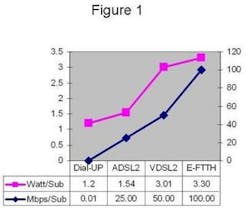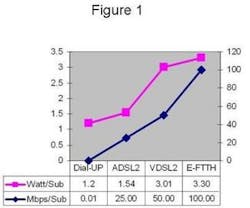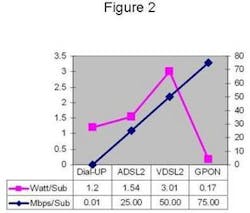Green is PON's color
By Dan Parsons
BroadLight
In the past 15 years, the telecommunication industry has been intensely focused on supplying more bandwidth to satisfy the ever-increasing consumer demand for high-speed internet, IPTV, gaming, and whatever other service that can be delivered satisfactorily over the network. The fallout has been a drastic increase in the power consumed at the central office (CO), along with a similarly drastic increase in the costs of supplying that power, both in terms of dollars and ultimately the far-reaching effects on the environment.
How much impact does the telecommunication industry's drive for higher access speeds have on the planet? Is there a technology that can slow the trend of higher power for higher speeds?
Erlang to always on
As has been thoroughly discussed elsewhere, the public switched telephone network (PSTN) was not originally engineered for Internet traffic. The PSTN capacity was based on a voice traffic density probability model as defined by the Erlang. In essence, for cost optimization, the telephone network was designed to accommodate what was considered a probable traffic load, and thus any telephone calls that exceed that capacity were given a busy signal. Likewise, power from the CO to the telephone handset was supplied only in an off-hook state whose probability of being in that state was determined by the Erlang.
With the advent of DSL and broadband Internet, subscriber power as supplied from the CO went from an Erlang probability to being on all the time. How much power are we talking about? For the telephone, it is 1.2 W (48-V battery x 25-mA loop current) supplied by the voice equipment only in the off-hook state. For a DSL line, the power is about 1.6 W supplied by the DSLAM continually. For VDSL2, whose power is about 3.6 W per subscriber, it can be said that the energy (power-time) required at the CO must increase from 0.12 W-hours (1.2 W x 6 minutes per hour) per telephone subscriber to 3.72 W-hours (3.6 W-hours + 0.12 W-hours) for VDSL2 and telephone service -- an increase of more than 30 times!
The cost of power
In some European countries, the incumbent service provider company consumes more than 2 TW-hours (2,000,000 MW-hours) of energy. As energy costs have more than doubled in the past five years in some of these countries, the service provider has reason for concern when technologies are implemented in the network that raise the power requirement by more than a factor of two as is the case where one migrates from ADSL2 to VDSL2.
To give this some perspective, a service provider with 6 million ADSL subscribers drawing 9,600 kW-hours (6 million x 1.6 W) of energy at $0.10 kW-hour faces a cost of about $660,000 per month or $8 million per year. This does not include the increased need for CO air conditioning.
Perhaps such a sum may seem a drop in the bucket for an operator with an annual opex budget in the billions of dollars. However, the amount of energy COs consume has a real impact on the environment.
The environmental impact
For the world's more than 220 million DSL subscribers, COs have to deliver about 352 MW of power. This power requirement has an energy impact which translates into an environmental carbon footprint that can be determined via a website maintained by the USA utility Pacific Gas and Electric (PG&E). From the carbon footprint calculator on the site, the energy consumed at the CO to power the world's 220 million DSL subscribers contributes over 1,500,000,000 lbs of carbon dioxide to the environment yearly! To describe the impact from a different angle, this figure is equivalent to the burning of 79,000,000 gallons of gasoline or the carbon dioxide contribution of 441,000 USA homes over the course of a year.
This is the impact of DSL at 1.6 W per subscriber. As the demand for broadband increases as per Nielsen's Law at a rate of 50% per year, does the power required at COs around the world also have to increase to the VDSL2 level of 3.6 W per subscriber?
The answer is no. In fact, as bandwidth increases, the energy required by the CO to supply higher connection speeds can even be lower than the days of dialup Internet. This is possible through certain fiber to the home (FTTH) technologies.
The green effect of PON
As household Internet connection speeds increased, fiber optics has had to come closer and closer to the home. In recent years, FTTH is becoming the choice of leading service providers as the means to meet residential bandwidth demands.
However, the fact that electrical power cannot be supplied over fiber as it can be over copper isn't the reason that switching to FTTH saves power. In fact, the power per subscriber consumed at the CO with an Ethernet FTTH architecture (E-FTTH, also know as point-to-point optical Ethernet) is almost the same as VDSL2. The simultaneous increase in subscriber connection speeds and dramatic decrease in CO power requirements occurs only with a passive optical network (PON) architecture.
For example, for a single GPON fiber-optic port with a downstream capacity of 2,300 Mbits/sec, up to 32 subscribers can be guaranteed at least 72 Mbits/sec of service. With recent GPON optical line terminal (OLT) technology at the CO, the power per subscriber is 0.21 W assuming a spit ratio of 32 subscribers per PON. Although point-to-point FTTH architectures may offer theoretically unlimited home connection speeds, they will always require at least 32 times (i.e., a number corresponding to the PON split ratio, now commonly 32) more power per subscriber than PON because every subscriber port needs a corresponding CO port.
To illustrate the bandwidth-power trend for point-to-point technologies, Figure 1 shows that as megabits/sec per subscriber increases so does the watts per subscriber.
In Figure 2, we see this increase in power with increased bandwidth paradigm is reversed with PON. Newly available GPON ASIC technology allows less than 7 W per OLT port at the CO or 0.21 W/subscriber (i.e., 7 W/32 subscribers) for even lower watts per subscriber than dialup access.
The question now is what is the overall impact of providing a GPON-based access network in comparison to other technologies? Applying the power characteristics of each technology to 1 million subscribers, the answer is given in Table 1.
Table 1 Technology comparison for 1 million subscribers
| GPON vs. | CO Energy Savings | Cost Savings | Environmental Savings |
| ADSL2 | 11 MW-hrs | $1.1M | 4.8M lbs of carbon dioxide = 250k gallons of gas |
| VDSL2 | 29 MW-hrs | $2.9M | 13.6M lbs of carbon dioxide = 700k gallons of gas |
| E-FTTH | 27 MW-hrs | $2.7M | 12.7M lbs of carbon dioxide = 655k gallons of gas |
| EPON | 2.4 MW-hrs | $0.24M | 1.2M lbs of carbon dioxide = 61k gallons of gas |
To put the environmental impact into something we can visualize, according to PG&E, changing one's car to a hybrid electric saves about 2,900 lbs of carbon dioxide a year. Thus, the GPON savings of 1.2 million lbs of carbon dioxide over EPON for 1 million subscribers is equivalent to 410 subscribers changing their gas-powered cars to hybrid electric; versus a VDLS2 network, the same savings accrue with about 4,700 subscribers.
As service providers invest in technologies to meet the demand that Nielsen's Law predicts, their technology choices will have a significant impact on the environment. European Commission (EC) studies foresee that by year 2015, in the absence of strong and direct action, the energy consumption of broadband equipment could sum up to 50 TW-hours, contributing significantly to the overall European energy budget.
In line with the European Union's energy and environmental policies, the EC took action through the preparation of a Code of Conduct on Energy Consumption of Broadband Equipment document that provides guidelines and principles for communication equipment at the CO and the home for limiting power consumption.
In physics, the conservation of energy states that the total amount of energy in an isolated system remains constant, although it may change forms. The efficient use of energy is one the hottest topics in research and development, and telecommunication technology suppliers are being challenged to apply this law for lower and more efficient use of energy at low cost.
As we have considered, GPON can also be referred to as Green PON. The energy it consumes and the bandwidth it delivers far surpasses any other access technology and shifts the power-bandwidth paradigm to a point even lower than dialup Internet. As GPON and other PON technologies are deployed en masse worldwide, the planet will be thankful.
Dan Parsonsis director of marketing at BroadLight.

